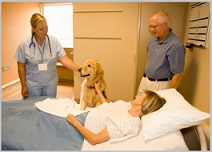Table Of Contents
Pet Therapy : Benefits, History, And How Does it Work?
Pet therapy capitalizes on the worldwide and universal truth that pet owners have always known: Pets are good for us!.
Our devoted pets are non-judgmental, intensely loyal, non-demanding, and uncritical. They shower us with unconditional love and complete adoration. They make us feel like we're the center of the universe.
That kind of devotion can't help but have a healing effect on people at every level!
What is Pet Therapy?

But medical professionals often prefer the official terms of animal assisted therapy (AAT) and animal assisted activities (AAA).
Early animal therapy programs were quite informal. They were often staffed by volunteers who brought their pets into hospitals, nursing homes and other long-term care facilities on a regular basis.
This unstructured pet visitation improved the quality of life for people with disabilities or chronic illness.
[AdSense-A]
Benefits of Pet Therapy

For people who are in difficult life situations, pets can be especially comforting. They provide their own brand of pet therapy by just being nearby. They help us through times of bereavement and depression.
With a cat or dog by our side, we're never alone. We feel happier and more secure just being near them.
Seeing the love and adoration in our pets' eyes is priceless pet therapy, and bound to raise our self-esteem and self-worth quite a few notches. We're less fearful, anxious when cuddling a cat or playing with a dog.
Spending time with our pets tends to lift our burdens and reduce stress.
Studies show that just petting your cat or dog will lower your blood pressure and heart rate. That's lots more fun--and cheaper--than taking pills!
An increasing number of psychiatrists, psychologists, and general practice physicians are prescribing pets for their patients -- prescription pet therapy! They're a great way to combat loneliness, depression, and other emotional problems including inactivity and stress. They recommend animals for companionship, to provide unconditional affection and warmth, to provide a focus or perspective, amusement, and a feeling of being needed. And our pets are happy to do all that just for room and board!
How Does Pet Therapy Work In Prisons?

A number of programs are in place where inmates help in the training of service dogs and assistance dogs.
The inmates learn to train and care for an animal that's dependent on them. In this case, pet therapy benefits both the trainers/inmates and the people with disabilities who receive companion animals to help them live fuller lives.
In other facilities, juvenile offenders learn compassion, respect, self-control and responsibility in the process of socializing and interacting with homeless rescue dogs.
[AdSense-A]
Pet Therapy in the Home

Our ability to form healthy relationships in adulthood may stem from our first positive experiences with pets.
Household animals are often special buddies with whom children can share their innermost dreams and secret thoughts during lonely or stressful times.
Pets can help teach children the responsibilities of daily living, compassion for others, and the cycles of life and death.
They help build trust, self-esteem and self-confidence through their outpouring of unconditional love.
Especially for the elderly, pets in the home may serve as a barrier against loneliness and depression.
They encourage physical activity and social interaction with one's neighbors -- "accidental" pet therapy that helps people keep active when they might not do so on their own.
They also add a sense of safety and protection.
They can provide opportunities for pet-related hobbies and clubs.
They may be the substitutes for absent children, helping reduce the "empty nest syndrome."
They give people a reason to get up in the morning.
Their internal clocks give us a sense of order and a daily ritual. (Your dog knowswhen it's time to eat!)
They help us forget our cares and worries, if only for a few minutes. They always give us something to talk about, and lots of opportunities for hugs and kisses--that important "touch factor."
History of Pet Therapy

Gardens were populated with small animals (rabbits and poultry) to help the patients learn responsibility and self-control by caring for something that needed their help.
During World War II, as Corporal William Wynne was recovering in an Army hospital in the Philippines, his pals brought his Yorkshire Terrier, Smoky, to the hospital to cheer him up.
Smoky immediately became a big hit with the other wounded soldiers, as well.
Observing the men's boost in morale, the commanding officer of the hospital unit, Dr. Charles Mayo, of the now famous Mayo Clinic, decided to take Smoky on his rounds.
Smoky's work as a therapy dog continued for 12 years, during and after World War II.
The establishment of a systematic approach to the use of dogs in pet therapy is attributed to Elaine Smith. He was an American who worked as a registered nurse for a time in England.
Smith noticed how well patients responded to visits by a certain chaplain and his canine companion, a Golden Retriever. As a result, and upon returning to the United States in 1976, Smith started a program for training dogs to visit institutions.
Does Pet Therapy "Cure" People?

In none of these cases are people "cured" by their pets. But animals reach them in ways that traditional medicine cannot. In that sense, pet therapy is an inexpensive and pleasurable remedy for many ailments.
Having always my own pets, I clearly understand what a vital role they play in our lives. I'm glad to see the medical community agrees with me!
[AdSense-A]
Similar Articles :
1- Tramadol For Dogs Toxicity.
2- Golden Retriever Lifespan .
3- Can Dogs Eat Grapes Or Not?? .
4- How To Stop Your Dog From Biting .
5- Golden Retriever Health Problems Issues.
6- Find Good Golden Retriever Forum.
7- How To Deal With An Golden Retriever Dog..
8- My Dog Ate Chocolate What Should I Do? .
9- Worming / Deworming Your Golden Retriever Puppies.
10- Golden Retriever Breed Standard.
10- How To Deal With An Aggressive Golden Retriever Dog.
11- How To HOW TO STOP YOUR DOG FROM BITING.
